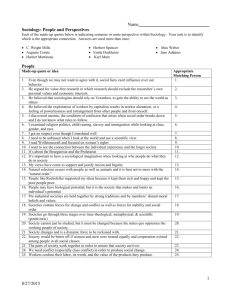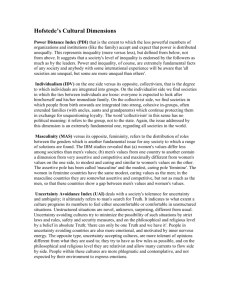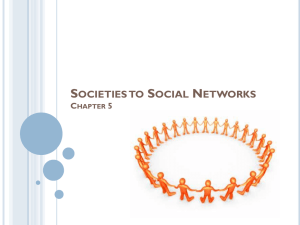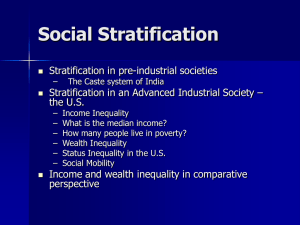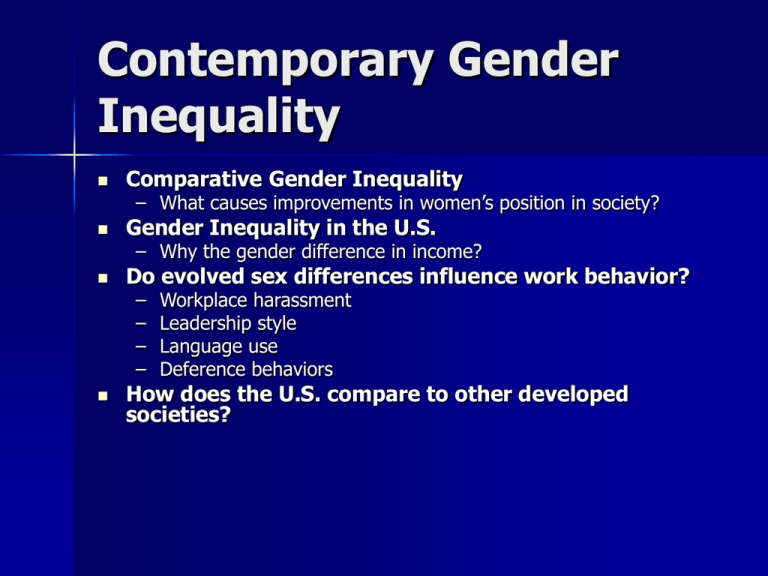
Contemporary Gender
Inequality
Comparative Gender Inequality
– What causes improvements in women’s position in society?
Gender Inequality in the U.S.
– Why the gender difference in income?
Do evolved sex differences influence work behavior?
–
–
–
–
Workplace harassment
Leadership style
Language use
Deference behaviors
How does the U.S. compare to other developed
societies?
There have been egalitarian societies,
and male-dominated societies
There have been no female-dominated
societies.
Even today, men have the most
political power in even the most
gender egalitarian societies such as
Sweden.
Percent of legislative seats
held by women, 2000
In general, gender inequality tracks
the amount of inequality in the society
as a whole
Lowest in h & g societies, highest in
agrarian societies, lower again in
industrial societies.
The most gender inequality today is
found in the developing, formerly
horticultural and agrarian societies of
Africa, Asia, and the Middle East.
In many of these societies,
discrimination against women is built
into the culture, and sometimes into
government policies and laws.
Girls are less likely to be sent to school
Women get paid less
Women’s wages in manufacturing, as a
percentage of men’s wages
Women may be beaten by men
Women reporting physical assault by male
partner, selected studies, 1990s.
Women suffer rape and worse during
wars
What causes improvements
in women’s position in
society?
Women’s position in society typically
improves with economic development.
Modernization theory suggest that this
happens immediately.
Other theories say it depends on the society
– Beliefs about women’s place in politics,
education, and the labor force
– Religious beliefs
Also important:
– government policies regarding the
education of boys and girls
– type of educational system
– Policies and laws about women, such as
the legality of abortion and the availability
of family leave
Gender Inequality in the
U.S.
Since 1967, women have joined the
paid labor force in the United States in
ever larger numbers
Women have experienced increases in
income at all educational levels and
have also experienced rising income
relative to that of men
Income inequality remains, however
In 2007, the median income for men
was $45,100, was $35,100 (full-time,
year-round workers only).
In families, women are better off
economically if they are married.
Female headed families are most likely
to be in poverty
Mother headed families
have the highest poverty
rates
Why the Gender Difference
in Income?
Women are in different jobs than men
are, and the types of jobs women
have tend to pay less than the types
of jobs men have.
Even for jobs in which women are a
majority of workers, men are more
likely to have the high level, better
paid positions.
Do evolved sex differences
influence work behavior?
Given their higher commitment to children,
women are more likely than men to have
competing demands on their time because
of child care considerations.
Some women may choose to work fewer
hours, take on less demanding jobs, or be
less career-oriented as a result.
Sexual harassment
Given their less investment in
prospective offspring, males are likely
to be less discriminating in potential
mates than females.
This promotes a greater interest in any
prospective mate—that is, any young
healthy female.
There is evidence that males are more
likely to read a sexual subtext in an
interaction than females.
This can lead to misunderstandings
about intent and resulting sexual
harassment.
Leadership Styles
Women generally lead differently to
men
Men tend to be more comfortable in
hierarchical social situations
– Tend to take a more directive approach to
leadership
Groups of women are based more on
equality of members than status, and
that women are less comfortable in a
hierarchical situation in the workplace.
– Tend to take a more consensus-based
approach to leadership
Language Use
Linguist Deborah Tannen suggests that
all male conversation may be seen as
a negotiation over status—who has it
and who does not.
Female conversation may be seen as
a negotiation for intimacy or
closeness.
Such sex differences in conversational
style can lead to misunderstandings
between men and women.
– Women may see male style and selfish
and egoistic
– Men may see females style as indecisive
Deference behaviors
There is much evidence from
experiments that young women are
more likely to defer, and young men
not defer, in mixed-sex interactions
These predispositions toward
deference behaviors may be innate.
May make positions of authority more
difficult for young women
How does the U.S. compare
to other developed
societies?
Women earn less
everywhere
In terms of authority in the workplace, in
most countries women have less authority
on the job than men
Rosenfeld et al. (1998) found that Australia
and the United States have high levels of
gender equality in authority, whereas
Sweden and Japan are at the lower end of
gender equality in authority.

